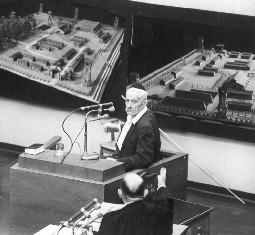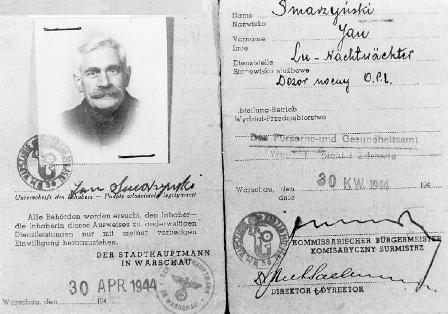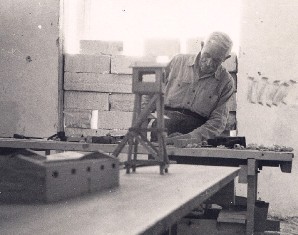Holocaust Education & Archive Research Team |
|
Trials Introduction to the Holocaust Trials
Trials
Interrogations & Testimonies
The IMT Series Nazi Justice
| ||
Jankiel Wiernik Testimony about Treblinka at the Eichmann Trial 1961 (Selected Extracts)
Jankiel Wiernik arrived in Treblinka death camp on the 23 August 1942 and he escaped during the revolt on the 2 August 1943.
Jankiel Wiernik was a master builder and he along with others built many of the structures in Treblinka, which he described at the Eichmann trial in Jerusalem in 1961:
“When I came there, there were only three gas chambers. The large kitchen was not there yet. I constructed various barracks, I built the guardroom. I built the door, the entrance gate.”
He described the arrival process:
“This is where they remained standing. In the courtyard, there were the two large barracks. They brought the women in to the left, and the men were kept outside. They made the women remove all their clothes.
The men remained standing outside. On either side, there were two large written notices to the effect that money and valuables had to be handed over, and whoever failed to do so would be put to death.
The women’s hair was cut off. At the end, a small area was fenced off their hair was cut off and then they were taken to the gas chambers.
Here (points to it) was a building with three gas chambers, in the large building there were ten gas chambers. The doors were closed and it lasted some forty to forty-five minutes.
Yankiel Wiernik was asked more questions about the layout of Treblinka:
“There were the ten gas chambers which they built when I was there, and these were the three gas chambers. The machines stood at the edge. That was the front, the side where people entered. The Shield of David was made the metal workers of the first camp.
Wiernik was asked how the two camps were divided.
“Here was the entrance- here is the first camp (points to it). All this belongs to the first camp. This was the Schlauch (the tube) the path along which people walked.
And here people went through the side, they went into the gas chambers. When the gas chambers were not yet in existence they went in this way (he indicates the spot).
This is what they called the Lazarett – they used to bring elderly people there, and underneath they put timber. They would seat the people on a bench, the back of their necks facing this way, and shoot them, so they would fall inside.
Here we made an entrance for the members of the SS and all those who were there on behalf of the SS. They made use of the entrance only. Above the gate, there was still a sign, “The Jewish State.”
Yankiel Wiernik recalled the larger gas chambers built in the late summer, early autumn of 1942:
“The gas chambers of the large building were seven by seven. The entire building was thirty –six metres in length and eighteen metres wide.
When the doors were open I did see them, the doors were open, they were open almost completely, and when they were opened, the dead bodies fell out, since they had been lying there crowded together. Into a room of 1.90 metres, they forced many inside.
It was a room. The floor was somewhat sloping when the people inside were suffocated, they used to wash the floor with a hosepipe or a bucket of water. When they removed the bodies, they had been suffocated.
Here was the gas engine, the engine what forced the gas in. And there were pipes with valves. They would open the valve into the chamber where the people were.
There was an engine of a Soviet tank standing there, and in this way the gas was introduced. Here were the doors where people entered from one side, and on the other, this was the large door which opened along almost the entire wall.
And after forty to forty-five minutes had passed, they would stop, they would open the door and the dead bodies would fall out. And here was a spare engine next to the three numbers 1, 2, 3 and 26 were the engines that generated the electricity, and there too, there was a motor.
Until the end of 1942 they did not burn those who had been gassed, but they would bury them in enormous pits. The bodies were placed inside. Only at the beginning of 1943 did they make various experiments of how to burn them and they did not succeed.
Then a certain Scharfuhrer arrived, an SS man, and he brought this model for the grids, and he always used to stand near the fire and shout “Tadellos, tadellos” (Perfect, perfect).
---------------------------------------------------------------------------------------------------------------------------------------------
Jankiel Wiernik wrote his memoirs from Treblinka in the end of 1943 in Warsaw where he was in a hiding place after the revolt in the camp and after his escape from there. Early 1944 the Polish and Jewish underground in occupied Warsaw decided to publish Wiernik's memoirs in two versions - Polish and English. The English version was smuggled from occupied Poland to London.
Sources:
The Complete Transcripts of the Eichmann trial – Nizkor US National Archives Ghetto Fighters House
Copyright. Johannes Weber H.E.A.R.T 2008
|



